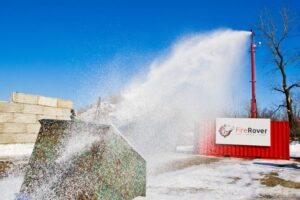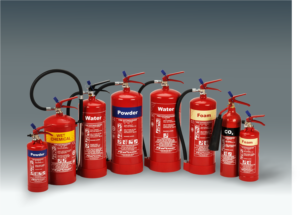
Fire Rover Cannon System
Fire Rover is the world’s only proactive fire prevention system that detects and extinguishes fires
A: We are grateful for all feedback and are pleased to hear you're happy with the service you're receiving. We would really appreciate your support in leaving us a Google review and we'll ensure this is shared with the employee/s.
A: We take all complaints seriously and would like to speak to you as a priority. If possible, please contact us on +44 (0)1234 357357. If you are unable to call, please complete this Complaint Form and a member of our customer service team will be in touch. Your complaint will be acknowledged within 24 hours, and we aim to resolve the complaint within 14 days.
A: We are sorry to hear you'd like to cancel your services with us. We'd appreciate the opportunity to resolve any issues, so please contact us on +44 (0)1234 357357 so that we can discuss your account. Please note our cancellation terms are detailed in our Terms and Conditions which can be found here.
A: We aim to contact customers to arrange service visits prior to the month that their service is due. If you haven't heard from us 30 days before your service is due, please complete our Service Booking Form.
A: If anything is unclear regarding a recent service, please complete our Service Query Form. We will review your query and one of our customer service team will be in touch shortly.
A: Call us on +44 (0)1234 357357 or email us at sales@dev.blazequel.com and one of our team will help get that set up.
A: Email us at sales@dev.blazequel.com, providing details of your query. Alternatively, you can reach us by phone at +44 (0)1234 357357.
A: You can contact us directly by emailing sales@dev.blazequel.com detailing your query, or alternatively you can give us a call on +44 (0)1234 357357. One of the team will then provide information on what happens next.
A: Our dedicated customer service team works at 06:30 - 17:00 Monday to Friday. For inquiries outside of these hours, you can reach out to us via email at sales@dev.blazequel.com, and we will respond as soon as possible.
A: We have two key locations to serve you. Our head office is in Bedford, United Kingdom and we have site operated in Londonderry Northern Ireland. Please feel free to contact us at any of these locations for assistance or further information.
Carbon Monoxide claims around 50 lives every year in the UK, making it one of the nation’s deadliest poisons. It’s essential to have CO (Carbon Monoxide) Detectors in any areas of your home or business where you have a solid fuel burning appliance. New Legislation has been introduced (October 2015) which requires residential landlords to install CO detection in their properties. Our handy guide will help you understand the obligations of this legislation.
Class A Fires are Fires involving flammable solids. COAL, WOOD, WOOL, CLOTH, STRAW
Class B Fires are Fires involving Flammable Liquids. PETROL, PARAFFIN, PAINTS, LUBE, SOLVENTS INCLUDES LIQUEFIABLE SOLIDS
Class C Fires are fires involving flammable gases. PROPANE, ACETYLENE, HYDROGEN, METHANE. Be careful of creating an explosion risk if tackling a Class C fire. The unburned gas could cause a potentially lethal explosion if it suddenly ignites. The best way to tackle a Class C Fire is to turn off of the gas supply.
Class D Fires are fires involving Flammable Metals. MAGNESIUM, TITANIUM, SODIUM, LITHIUM.
Class F Fires are Fires involving cooking Fats and Oils. FAT, MARGARINE, BUTTER, LARD.
The ‘Fire Rating’ of an extinguisher is the measure of the size of fire it can tackle. For instance, a 9lt Foam Extinguisher which we supply has a 21A, 183B fire rating. This means that it can be used to tackle a fire of up to 21kg of flammable solids, or 183lt of flammable liquids. These ratings are set by independent laboratories, using a consistent testing procedure. The fire fighting is done by a professional fire fighter. It’s important to remember this, as when the extinguisher is in the hands of a professional it is capable of much greater performance than may be achieved by someone who only has minimal training.
The ‘Feedback Loop of Fire’ is the self-reciprocating action of a fire to sustain itself and grow. As a fire burns, the flames generate heat, which in turn heats the fuel source to create more ‘Free Radicals’. These free radicals are the flammable particles released from the fuel which burn. Now, the free radicals which have just been released will burn, creating more flames and heating the fuel still further. This in turn releases more free radicals, and so the cycle continues and supplements its own growth.
The Fire Triangle refers to the three-sided diagram showing the critical components required for the chemical reaction of fire. This diagram lays the basis for all fire lighting and fire extinguishing techniques. If all three components (Heat, Oxygen and Fuel) are combined in sufficient quantities, combustion instantly occurs. However, if at least one of the components are removed, the chemical reaction can no longer continue and the fire is extinguished. All fire fighting agents seek to remove at least one side of the triangle. Water-based agents remove the heat from the fire. Powder and gaseous agents dispel the oxygen and suffocate the fire. Aerosol agents attack the free radicals and starve the fire of fuel. However, more advanced systems such as Water Mist Suppression systems primarily removes the heat but, due to processes during discharge, the volume of steam produced dispels the oxygen from the area. This removes two sides of the Fire Triangle and reduces the possibility of re-ignition, ensuring complete extinguishment and making this system extremely effective.
Free radicals form the basis of fire. When a material warms, molecules vibrate from side to side. As they do so, some break away from the main body of material. These are what is known as Free Radicals. Due to now increased surface area of the material, sufficient oxygen can reach the free radical for combustion. Providing the temperature is high enough, an exothermic reaction ensues which emits radiation in the visible light band. This is what we call flame. This exothermic reaction further increases the heat in the area, causing the molecules in the body of material to vibrate even more, thereby emitting more free radicals. It is due to this that fires are seen to grow in heat and violence. Free Radicals also are the basis of fire extinguishing systems: Cooling material down via liquid-based agents (e.g. Water Extinguishers) reduces the amount of free radicals being emitted Reducing the concentration of oxygen via gaseous suppression agents means that the chemical reaction is cut short Attacking and changing the chemical composition of the free radicals via aerosol suppression agents effectively eliminates the material’s ability to burn.
HSSD means High Sensitivity Smoke Detection [sitelink to HSSD page]. This fire alarm detection technology is extremely effective at protecting high risk facilities, clean room areas, extraction and ventilation systems etc.
Open Protocol Fire Alarm Panel
Open Protocol refers to the accessibility of system parts, devices, software and service/commissioning codes and passwords for the fire alarm panel. An open-protocol system has an open supply chain for all of these parts, and does not restrict you to a single service provider for ongoing support and maintenance. Conversely, a ‘Closed Protocol’ system (i.e. Gent, Protec, ADT) has a restricted supply chain. Only specifically licensed companies (sometimes only one company) is able to get full access to replacement parts. Commissioning and modifications to the control panel configurations (which require access to software) can only be completed by these licensed companies. In short, the competitive field for you – the client – to seek a service provider who provides the level of support you require is greatly limited. You can only work with the authorized company/companies. As a result, prices are often higher, service is poorer and access to parts can be stunted by an non-competitive supply chain. At Blazequel, we don’t subscribe to the ‘Closed Protocol’ approach. We believe that customer loyalty should be earned – not forced. With a year-on-year customer retention of over 99%, without any fixed-term contracts, we continue to implement open-protocol fire alarm solutions for thousands of customers annually. For many years we have used the Advanced Fire Alarm Panel range (now also FM Approved), which is the market-leader in Open Protocol fire alarm panels
The phrase ‘Point Type’ Detector refers to the standard ceiling mounted detector which is shaped roughly like a cone, where the base of the cone contains the sensors for the detector. Heat Detection is ideal for areas where smoke detection may be set off by the day to day activities taking place. They are commonly used in kitchen areas, plant rooms and low level warehouses. Point type heat detectors should not be used on ceilings higher than 7.5m for fixed temperature heat detectors, or 9.5m high for rate of rise heat detectors (which detect an unusually rapid increase in temperature).
The phrase ‘Point Type’ Detector refers to the standard ceiling mounted detector which is shaped roughly like a cone, where the base of the cone contains the sensors for the detector. Smoke detection is ideal for the vast majority of fire risks and applications, from offices and comms rooms through to warehousing. There are two main types of point type smoke detector – Ionization and Optical detection. Ionization Detectors – have a small amount of radioactive material between two electrically charged plates, which ionizes the air and causes current to flow between the plates. When smoke enters the chamber, it disrupts the flow of ions, thus reducing the flow of current and triggering the detector. Ionization detectors are ideal for detecting fast flaming fires. Optical Detectors – use an internal light source within the detector to monitor levels of obscuration to detect the presence of smoke. They are excellent for detecting smoldering fires.
Smoke Stratification occurs when a layer of warm air (a Stratus) collects at roof level. As smoke from a fire low-energy fire rises, it reaches this thermal barrier and lacks the energy to rise further. This causes the smoke to build up below the level of the stratus, creating a smoke plateau (see diagram below). Stratification generally effects high-level buildings such as Atriums, Aircraft Hangers, Warehouses and Waste Management Facilities.

Fire Rover is the world’s only proactive fire prevention system that detects and extinguishes fires

savex, rationally moulded, composite, tabular steel, circular based stainless stand

it’s essential to match your fire extinguishers to your unique needs.
If you have questions call us at +44 (0)1234 357357 or email us at sales@dev.blazequel.com or book a free consultation with us.
